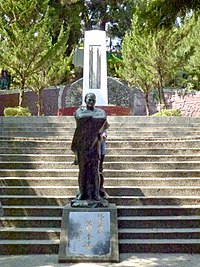| 賽德克族 Seediq | |
|---|---|
 A statue of Mona Rudao at the Wushe Incident Memorial Park A statue of Mona Rudao at the Wushe Incident Memorial Park | |
| Total population | |
| 10,485 (April 2020) | |
| Regions with significant populations | |
| Hualien and Nantou county (Taiwan) | |
| Languages | |
| Seediq, Mandarin Chinese | |
| Religion | |
| Animism, Christianity | |
| Related ethnic groups | |
| Atayal, Truku, Kavalan, Taiwanese Aborigines |
The Seediq (sometimes Sediq, Seejiq, pronounced: [seˈʔediq], [səˈdiq], [səˈʔəɟiq]; Chinese: 賽德克族; pinyin: Sàidékèzú) are a Taiwanese indigenous people who live primarily in Nantou County and Hualien County. Their language is also known as Seediq.
They were officially recognized as Taiwan's 14th indigenous group on 23 April 2008. Previously, the Seediq, along with the closely related Truku people, were classified as Atayal.
Resistance to colonization
Wushe events
Starting from 1897, the Japanese began a road building program that brought them into the indigenous people's territory. This was seen as invasive. Contacts and conflicts escalated and some indigenous people were killed. In 1901, in a battle with the Japanese, indigenous people defeated 670 Japanese soldiers. As a result of this, in 1902, the Japanese isolated Wushe.
Between 1914 and 1917, Japanese forces carried out an aggressive 'pacification' program killing many resisting people. At this time, the leader of Mahebo, Mona Rudao, tried to resist rule by Japan, but he failed twice because his plans were divulged. At his third attempt, he organized seven out of twelve groups to fight against the Japanese forces.
Xincheng events
Main article: Xincheng IncidentWhen Japanese soldiers raped indigenous women, two leaders and twenty men killed thirteen Japanese soldiers.
Renzhiguan events, 1902
After taking over the plain, Japanese gained control of Wushe. Some of the Tgdaya people who resisted the Japanese were shot. Because of this, fighting broke out again, leading to the Wushe incident.
Zimeiyuan incident, 1903
In 1903 the Japanese launched a punitive expedition to seek revenge for their earlier loss at Renzhiguan.
Truku War, 1914
Main article: Truku WarThe Japanese wanted to subjugate the Truku group. After eight years of investigating the area, they invaded in 1914. Two thousand of the indigenous people took part in resisting the invasion. The Japanese deployed 200 machine guns and 10,000 soldiers against the Aboriginals, but grievous wounds were inflicted upon the Japanese Governor-General Sakuma Samata during the war and caused his eventual death.
Wushe Incident, 1930
Main article: Wushe Incident
The Musha Incident (Chinese and Japanese: 霧社事件 Chinese and Japanese: 霧社事件; pinyin: Wùshè Shìjiàn; Wade–Giles: Wu-she Shih-chien; Pe̍h-ōe-jī: Bū-siā Sū-kiāⁿ rōmaji: Musha Jiken), also known as the Wushe Rebellion and several other similar names, began in October 1930 and was the last major uprising against colonial Japanese forces in Japanese Taiwan. In response to long-term oppression by Japanese authorities, the Seediq indigenous group in Musha (Wushe) attacked the village, killing over 130 Japanese. In response, the Japanese led a relentless counter-attack, killing over 600 Seediq in retaliation. The handling of the incident by the Japanese authorities was strongly criticised, leading to many changes in aboriginal policy.
In popular culture

The Seediq people featured prominently in the 2011 Taiwanese historical drama film Seediq Bale which depicted the 1930 Wushe Incident along with the earlier Renzhiguan and Zimeiyuan incidents. The Wushe Incident was depicted three times in movies including in 1957 in the film 青山碧血 Qing Shan bi xue, It was also depicted in the 2003 TV Drama Dana Sakura [zh].
The albums Seediq Bale (2007) and Takasago Army (2011) by Taiwanese extreme metal band Chthonic talk about the experiences of the Seediq people during the first half of the 20th century presented through fictionalized narratives.
Notable people
- Iwan Nawi, Deputy Minister of Council of Indigenous Peoples
- Mona Rudao, A major figure during the Wushe Incident and a national hero of Taiwan.
- Walis Perin, Politician, Roman Catholic priest and Minister of the Council of Indigenous Peoples from 2005 to 2007.
- Kung Wen-chi, Taiwanese legislator
- Umin Boya, Taiwanese writer, director, actor
See also
References
- "賽德克族", 行政院原住民族委員會, 2015年/12月10日查閱.
- Shih, Hsiu-chuan; Loa, Iok-sin (24 April 2008). "Sediq recognized as 14th tribe". Taipei Times. Retrieved 12 June 2016.
- 新城事件 - 臺灣原住民歷史語言文化大辭典網路版
- 新城事件歷史現場變遷
- 新城事件
- 新城天主堂 - 花蓮觀光資訊網> 太魯閣地區> 熱門景點
- 花蓮縣文化局> 文化資產
- 文化視野:太魯閣事件的開端:新城事件- 台灣立報
- 太魯閣族抗日戰役史- 和平國小台灣母語日暨原住民資源網
- 104年台灣原住民族史(含概要、大意)-看這本就夠了
- 國立自然科學博物館-> 賽德克-巴萊特展-> 事件-> 人止關
- 人止關事件 - 臺灣原住民歷史語言文化大辭典網路版
- 寫真霧社事件台灣多樣性知識網焦點特展
- 國立自然科學博物館-> 賽德克-巴萊特展-> 事件-> 姊妹原事件
- 姐妹原事件 - 臺灣原住民歷史語言文化大辭典網路版
- 眉溪部落姜仁和耆老-姊妹原事件-數位典藏與學習聯合目錄
- 姊妹原事件 - VCenter - 您的影音中心- 數位典藏國家型計畫
- 真相.巴萊: 《賽德克・巴萊》的歷史真相與隨拍札記 (Seediq Bale 5)
- 臺灣原住民族文化知識網 歷史事件
- 太魯閣戰爭百年回顧
- 被遺忘的戰役_太魯閣戰役.mpg - YouTube
- 太魯閣戰役(電影粉絲團) - 【影片】百年血淚!被 ...
- 太魯閣事件 - 臺灣原住民歷史語言文化大辭典網路版
- 太魯閣戰爭 - 臺灣原住民歷史語言文化大辭典網路版
- 太魯閣 - 臺灣原住民數位博物館 Archived 2015-04-02 at the Wayback Machine
- 2014年「太魯閣族抗日戰爭紀念系列活動」官方網站- 本站消息
- 2014年「太魯閣族抗日戰爭紀念系列活動」官方網站- Dxgal o ...
- Tsai 2005, p. 12.
- Tsai 2009, p. 134.
- darryl (January 4, 2012). "Subjective, objective and indigenous history: Seediq Bale's take on the Wushe Incident". Savage Minds.
- Lee 2012, p. 395.
- https://www.facebook.com/note.php?note_id=10150202621017190
External links
- Sediq recognized as 14th group - Taipei Times, 24 April 2008
- RTI.org
| Taiwanese indigenous peoples | |
|---|---|
| Nationally recognized | |
| Locally recognized | |
| Unrecognized | |
| Ethnic groups of Taiwan | |||||||||||
|---|---|---|---|---|---|---|---|---|---|---|---|
| Han Chinese | |||||||||||
| Ethnic minorities |
| ||||||||||
| Immigrants and expatriates |
| ||||||||||